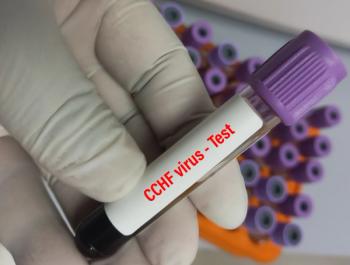
Additional Dose of IVIG Provides Positive Therapeutic Effect in Patients With Infliximab-Refractory Kawasaki Disease
Key Takeaways
- Additional IVIG in IFX-refractory KD shows comparable efficacy to a second IVIG dose in IVIG-resistant KD patients.
- Fever resolution times were similar between patients receiving IVIG after IFX and those receiving a second IVIG dose.
Additional intravenous immunoglobulin (IVIG) treatment shows promise for patients with Kawasaki disease who are resistant to infliximab, potentially matching the efficacy of second IVIG doses in patients resistant to IVIG.
An additional dose of intravenous immunoglobulin (IVIG) in patients with infliximab (IFX)-refractory Kawasaki disease (KD) could potentially have a therapeutic effect comparable to that of a second dose of IVIG in patients with IVIG-resistant KD, according to the results of a cohort study published by study authors in Pediatric Rheumatology.1
Overcoming IVIG Resistance in Kawasaki Disease
IVIG has been established for decades as an effective first-line treatment for pediatric patients with KD. Published guidelines from the American Heart Association and other medical associations recommend IVIG, with aspirin, if necessary, for initial KD treatment. However, many patients with KD—around 10% to 20%, according to reports—experience IVIG resistance.2,3
Clinical characteristics that could indicate IVIG resistance in KD include a higher frequency of extremity changes, tachypnea, irritability, and KD shock syndrome, according to previously published literature. Determining whether a patient is resistant to IVIG is critical, as those patients are believed to have a higher risk of developing coronary artery lesions (CALs). Though a second infusion of IVIG or IVIG in combination with glucocorticoids is often relied on for IVIG-resistant KD, IFX, a monoclonal antibody, has shown promise in clinical trials of patients with KD.4
Investigators have determined that IFX could provide a shorter fever duration when used for patients resistant to the initial IVIG treatment when compared with a second IVIG dose, suggesting that it could be a promising strategy for treating this patient population. However, surveys conducted in Japan indicate that some patients still require additional treatment following IFX infusion for IVIG-resistant KD. Therefore, the current investigators conducted a cohort study using electronic medical records to assess the therapeutic effect of additional IVIG treatment for IFX-refractory KD.1,5
Second Dose of IVIG Following IFX Has Therapeutic Benefits in KD
Data were gathered from 38 patients who received a second dose of IVIG after an initial dose (second-IVIG group) and 27 patients who received IVIG after a dose of IFX (IVIG-after-IFX group). Kaplan-Meier curves were used to depict the time until fever resolution following either treatment regimen. After their calculations, the investigators found no apparent differences between each of the curves (P = .783; hazard ratio [HR]: 1.00; 95% CI, 0.58-1.70). In the IVIG-after-IFX group, median time to fever resolution was 1.0 day (95% CI, 0.5-2.0), while it was also 1.0 day (95% CI, 0.5-1.5) in the second-IVIG group. Furthermore, fever resolution after 2.0 days was seen in 78% of IVIG-after-IFX patients and 68% of second-IVIG patients.1
CAL frequency, given the seriousness and frequency in patients with KD resistant to IVIG, was also investigated. In the cohort of IVIG-after-IFX patients, 7 cases of CALs were identified prior to initiating treatment, while 2 cases showed new CALs following the treatment. Comparatively, CALs were not identified in any case at diagnosis in the second-IVIG group. These data indicate that the frequency of CALs should be continuously monitored in patients with KD regardless of treatment regimen.1
Given their use in combination with IVIG to treat patients resistant to initial IVIG treatment, corticosteroid utilization was examined. Among the patients who received IVIG after IFX, 13 received corticosteroids and 14 did not. The study authors found that the median time to fever resolution was longer for those who received corticosteroids than for the noncorticosteroid group, but there was not a major difference observed (2.0 days vs 0.75 days; P = .323; HR: 0.76; 95% CI, 0.31-1.86).1
“Additional IVIG for IFX-refractory KD may have a therapeutic effect comparable to that of the second IVIG treatment for IVIG-resistant KD. IVIG would therefore be a hopeful therapeutic option for IFX-refractory KD,” the investigators concluded. "Treatment of IFX-refractory KD remains a challenge for us and requires further exploration, particularly regarding CAL prevention.”1
REFERENCES
1. Hatano S, Nakao H, Masuda H, et al. Effect of additional intravenous immunoglobulin for infliximab-refractory Kawasaki disease: a cohort study. Ped Rheum. 2025;23(49). doi:10.1186/s12969-025-01108-0
2. McCrindle BW, Rowley AH, Newburger JW, et al. Diagnosis, treatment, and long-term management of Kawasaki disease: A scientific statement for health professionals from the American Heart Association. Circulation. 2017;135(17). doi:10.1161/CIR.0000000000000484
3. Casinghino S. Researchers identify predictors of intravenous immunoglobulin resistance in patients with Kawasaki disease. Pharmacy Times. Pubished August 19, 2024. Accessed May 21, 2025. https://www.pharmacytimes.com/view/researchers-identify-predictors-of-intravenous-immunoglobulin-resistance-in-patients-with-kawasaki-disease
4. Masaru M, Tohru K, Toru I, et al. Real-world safety and effectiveness of infliximab in pediatric patients with acute Kawasaki disease: A postmarketing surveillance in Japan (SAKURA study). Ped Infect Disease Journ. 2020;39(10):41-47. doi:10.1097/INF.0000000000002503
5. Halpern L. High-dose IVIG with glucocorticoids shown to benefit patients with Kawasaki disease at high risk for IVIG resistance. Pharmacy Times. Published October 15, 2024. Accessed May 21, 2025. https://www.pharmacytimes.com/view/high-dose-ivig-with-glucocorticoids-shown-to-benefit-patients-with-kawasaki-disease-at-high-risk-for-ivig-resistance
Newsletter
Stay informed on drug updates, treatment guidelines, and pharmacy practice trends—subscribe to Pharmacy Times for weekly clinical insights.


















































































































































































































